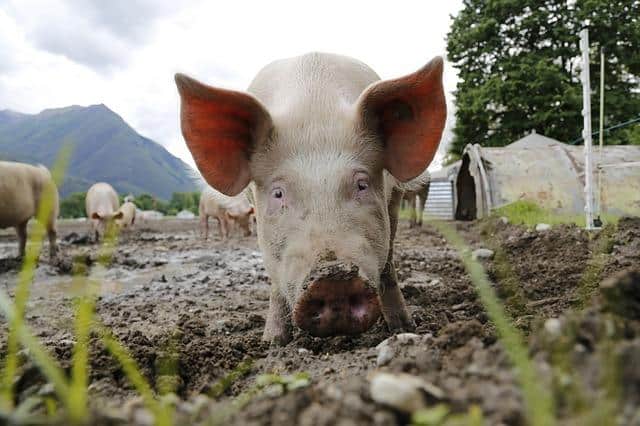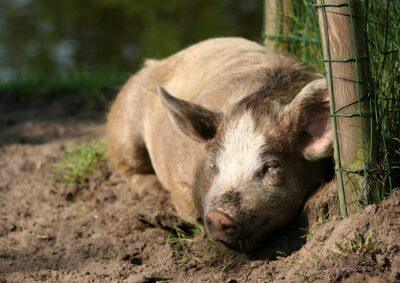Pigs are easy to keep in with an electric fence, but training them to respect it is critical.
When we start new piglets [2] here on our farm, we always take them through a training process. Without training them, you will end up with pigs that constantly get out. That’s never a good way to keep your neighbors happy.
Keep in mind: An electric fence is a mental barrier, and not a physical barrier. A physical barrier is something like a hog panel or woven wire fence. They physically can’t get through it.
Two little wires would never keep a pig in, but once you train them that no matter what happens they can’t get through it, they’ll respect the boundaries and stay right where you want them.
Pigs will typically get out of an electric fence for a couple of reasons:
1) The fence charger does not carry enough power to cause avoidance.
2) The wires are not at the proper height.
Occasionally, you get a pig that runs through the fence accidentally and then figures out how to slip the wire. If you don’t put a stop to it immediately, then they will get out anytime they feel like exploring.
Looking For An All-Natural Pesticide For Your Garden? [3]
By slipping the wire, I mean putting their head down and bolting under the wire. They usually get right up to the fence and drop down and squeal as they keep right on going!
Your only choice is to re-train them, or they will teach the rest and then you’re in for a long chase. Worse yet, they could escape and cause an accident on the road.
How to Start the Training
The critical part of the training is to allow the pigs to have contact with the hot wire but never be able to get past it or go through the wire.
If all you had was a wire with no physical barrier behind it, then the pig would likely run through it the first time he gets shocked and your fence would be torn. If they repeat that a few times, forget ever keeping pigs in with only electric fence wire.
So to avoid the pigs ever learning they can get through the electric wire, we put them in a training pen.
A good example would be a pen made out of hog panels, with a couple of hot wires around the inside at the proper height, which is nose height for pigs. Make sure the pen is big enough that they can get well away from the electric wire.
If the pen is fairly small, then you’ll have better luck with a hot wire on one or two sides instead of all four. They need a safe area to escape until they make the connection that it is the little wire that bites — and only if they touch it.
If a pig gets shocked in front of the eyes, then 99 times out of 100 he’ll back up. But if he gets “hit” behind the eyes, he will lounge forward.
So we train in the pen with a hot wire and a physical barrier. Then if he lounges forward, he can’t get through the physical barrier. He quickly learns to get away from the hot wire, and not to lounge through it.
I’ve had older pigs that had no electric fence experience get into the wire and run down the fence for 15 or 20 feet determined to get through it. It didn’t take them long to figure out they were in a losing battle!
Tie flags on the wire every three feet or so. Pigs will learn to associate the flags with the shock and avoid them. When you put them out on pasture, use the same flags and they won’t even test the fence because they “know” they can’t get past it.
I have found a good flagging material is surveyor’s tape. It’s bright orange or pink and you can get it by the roll at any home improvement store. It lasts for a long time, and the colorful tape keeps you from running into it with equipment or your bare leg!
How Much Power Do You Need?
There are many fence chargers on the market, but a good rule of thumb is to purchase one that powers two or three times as much fence as you think you’ll need. You usually end up running more fence than you ever planned to in the beginning anyway, so get a charger once and be done with it.
You want a charger that is low impedance and at least three joules.
I currently use a 15-joule charger, and even my old sows do not fool with the fence. It can stand heavy weed pressure or even have a deer run through it and be on the ground — and pigs stay put.
We use two strands of wire for almost everything except with sows, and many times only a single strand.
Once the pigs are trained, if the fence is hot enough and visible to the pigs, you can relax knowing they will stay where you put them.
Do you have any advice for training pigs with an electric fence? Share your advice in the section below:

